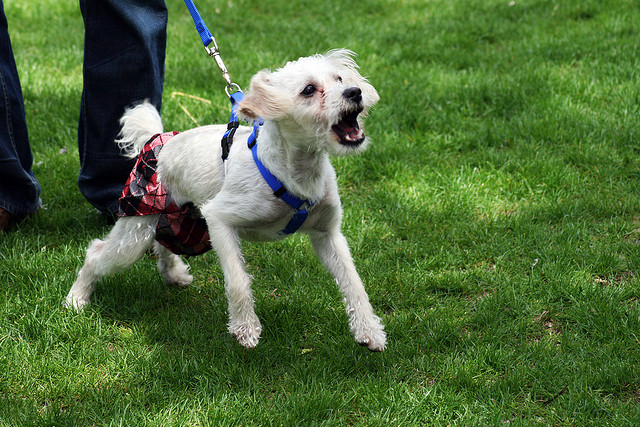When it comes to puppy socialization, the emphasis is always on taking your puppy to a doggy daycare, dog park, or a “play date,” where they learn how to interact with other dogs appropriately during play. Even in puppy class, the only introductions are done off-leash at the end of class during play time. And while off-leash interaction IS important, the reality is that 90 percent of the time your dog will be seeing and/or greeting other dogs while ON leash.
As a trainer, I have noticed an increasing number of dogs with on leash reactivity issues and I believe some of it stems from us never teaching them how to properly deal with other dogs (or humans!) while restrained on leash.
“Today, many dogs live in locations where they must be primarily exercised and socialized on lead,” explains Amber Burckhalter Chairman, Association of Professional Dog Trainers (APDT) Board of Trustees. “The quality of both the dog’s life and their relationship with their human greatly increases when the dog is well socialized, trained and comfortable on a lead around other dogs and strangers. Dogs who are trained, comfortable and well socialized on lead are able to enjoy a much more active and exciting lifestyle.”
APDT Tips to Socialize Your Dog On-Leash
Burckhalter, on behalf of the APDT, shares the following tips to help you ensure your dog acts properly on-leash.
- Decided how you would like the dog to behave during greetings. Seems simple, but often we do not think about what behavior we do want (sit, look at you, etc.) and only react to poor behavior.
- Train the dog to behave this way with lower level distractions such as walks in new areas of your neighborhood.
- Once your dog has accomplished correct behavior to these lower level distractions, introduce a known friendly dog and/or person on lead. Ask for the same behaviors and reward those behaviors.
- Verbally praise and if you notice any stress or tension from either dog, end the greeting in an upbeat manner. Keep the leash loose and allow the dogs to sniff and circle and keep initial greetings short.
- Focus on what you do want to dog to do, and reward that behavior.
- Respect your dog and their need for space and do not ask your dog to sit or lie down if they are feeling threatened.

Cautions
In addition to the above tips, be cautious when choosing who to greet. Dogs have fairly good memories and one bad experience can solidify how they react every time they see another dog or human from then on. Just ask someone who has had a dog attacked by another dog. Suddenly, their dog is afraid of every dog.
So, make sure you are letting your dog only greet other dogs that are appropriate: friendly, relaxed body posture (no stiffness, tail in neutral position, no staring or “posturing”).
Beware of “muscle tension, stiffness, cowering, hiding behind the owner, large whites of the eyes, growling, crying out, consistently looking away from and or avoiding the other dog or person, resisting the introduction, just to name a few,” says Burckhalter.

If either your dog or the other dog is showing these signs, DO NOT LET THEM GREET.
Also, if you are unsure, do not trust the owner’s word, just say no! Better to be safe than sorry. You dog does not have to great every dog in order to have a fulfilling life. Do you greet every person you see? Do you want to? Well, same goes for your dog.
The other dog should also greet correctly, meaning going to your dog’s rear-end instead of head on. Sniffing noses is not the correct way to greet and can quickly escalate into a fight.

Help for the Leash-reactive Dog
There are a lot of reasons why dogs can become reactive on leash. Fear, aggression, resource guarding, lack of social skills, frustration, are just a few reasons. Your dog may react for one or all of these.
If you have a dog that is already is leash-reactive, do not force them to greet or try to fix this on your own.
“Many dogs can overcome leash reactivity issues,” says Burckhalter. “However, until the owner can work toward that goal with a professional, avoiding situations that force the dog to repeat or practice the reactivity is best.”
You can make the situation worse by trying to force or dog or trying to train him on your own if you do not know the correct methods. Your dog could end up attacking a dog or human, which could result in your dog having to be euthanized. Leash-reactivity is not something that should be taken lightly. However, with the help of a professional dog trainer, you can overcome it. To find a certified professional dog trainer near you, search here.
About the Author
Based in Wilsonville, Ore., animal lover Kristina N. Lotz is a Certified Professional Dog Trainer – Knowledge Assessed (CPDT-KA). She is the founder of A Fairytail House. In her spare time, she trains and competes in herding, agility, obedience, rally, and conformation with her Shetland Sheepdogs. She smartly married a Veterinary Technician, who helps keep the fur kids happy and healthy, and provides a quick resource for articles.
